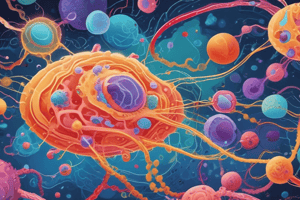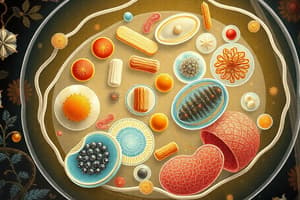Podcast
Questions and Answers
Which of the following are pathways for protein transport?
Which of the following are pathways for protein transport?
- Nuclear pores (correct)
- Membrane transport (correct)
- Endocytosis
- Vesicle transport (correct)
What is the size limit for passive diffusion into the nucleus?
What is the size limit for passive diffusion into the nucleus?
60 kDa
MRNA export utilizes Ran GTPase.
MRNA export utilizes Ran GTPase.
False (B)
What molecule is primarily inside the nucleus and releases imported proteins?
What molecule is primarily inside the nucleus and releases imported proteins?
Ribosomes bind to the ER via _____ upon targeting proteins for secretion.
Ribosomes bind to the ER via _____ upon targeting proteins for secretion.
What is the primary function of lysosomes?
What is the primary function of lysosomes?
Which of the following types of cell-to-cell signaling is long-distance?
Which of the following types of cell-to-cell signaling is long-distance?
Match the following types of receptors to the molecules they bind:
Match the following types of receptors to the molecules they bind:
Kinases remove phosphates from proteins.
Kinases remove phosphates from proteins.
What do Rho GTPases regulate?
What do Rho GTPases regulate?
The cytoskeleton includes three types: microtubules, _____, and intermediate filaments.
The cytoskeleton includes three types: microtubules, _____, and intermediate filaments.
Which of the following pathways is involved in RTK signaling?
Which of the following pathways is involved in RTK signaling?
Flashcards
Protein Transport Pathways
Protein Transport Pathways
The three main ways proteins move within a cell: through nuclear pores, across membranes, and via vesicles.
Nuclear Localization Signal (NLS)
Nuclear Localization Signal (NLS)
A specific amino acid sequence that directs a protein to the nucleus.
Ran GTPase
Ran GTPase
A protein that helps proteins enter and exit the nucleus by cycling between GTP and GDP.
Signal Recognition Particle (SRP)
Signal Recognition Particle (SRP)
Signup and view all the flashcards
Endocytosis
Endocytosis
Signup and view all the flashcards
Exocytosis
Exocytosis
Signup and view all the flashcards
Golgi apparatus
Golgi apparatus
Signup and view all the flashcards
Lysosomes
Lysosomes
Signup and view all the flashcards
Endocrine signaling
Endocrine signaling
Signup and view all the flashcards
Microtubules
Microtubules
Signup and view all the flashcards
Study Notes
Intracellular Compartments and Protein Transport
- Three main protein transport pathways: nuclear pores, membrane transport, vesicle transport
- Nuclear import requires a nuclear localization signal (NLS) and importin; size limit is approximately 60kDa (550 amino acids) for passive diffusion
- Ran GTPase is crucial; GTP form is primarily in the nucleus, releasing imported proteins upon binding
- mRNA export differs from protein export; it doesn't use Ran GTPase but relies on cap-binding proteins
- Ribosomes bind to the ER via signal-recognition particle (SRP) for protein secretion targeting
- SRP binds signal peptide, docks at SRP receptor; protein translocates across ER membrane
- Clathrin-mediated endocytosis involves adaptin, clathrin, and dynamin
- Exocytosis uses SNAREs (v-SNARE on vesicle, t-SNARE on target) and Rab GTPase
- Glycosylation occurs in the ER, attaching carbohydrate chains to asparagine residues on proteins
- Golgi apparatus has cis (nucleus-facing) and trans (cell edge-facing) regions; modifies proteins and synthesizes sphingolipids
- Lysosomes maintain low pH via H+ pumps, activating enzymes
- Transcytosis is the process of moving large molecules across cells without direct channel transport
Cell Signaling
- Signaling types include endocrine (hormones, long-distance), paracrine (local), autocrine (self-targeting), and juxtacrine (contact-dependent)
- Cell-surface receptors are for hydrophilic molecules; intracellular receptors for small, hydrophobic molecules.
- Signaling outcomes can include cell survival, growth, division, differentiation, or death
- Kinases add phosphates; phosphatases remove them from proteins; GTP-binding proteins act as molecular switches.
- Receptor Tyrosine Kinase (RTK) signaling: ligand binding causes dimerization, kinase activation, and autophosphorylation, leading to Ras-MAPK pathways(growth/division) and PI3-K/Akt pathways(survival/metabolism)
- G protein-coupled receptor (GPCR) signaling: ligand binding activates heterotrimeric G protein; key pathways include PKA activation (affecting glycogen breakdown, gene expression, Ca2+ release)
- Other signaling types include NO signaling (diffusing gas), Notch signaling (contact-dependent, development-focused), steroid signaling(intracellular receptors)
- SH2 domains recognize phosphorylated tyrosine residues on signaling proteins.
Cytoskeleton
- Cytoskeleton types include microtubules (a/β-tubulin dimers, dynamic, 13 protofilaments), actin filaments (ATP-dependent), and intermediate filaments (nonpolar, providing support)
- Microtubules function in intracellular transport and cell division; structures like lamellipodia/filopodia allow for cell movement
- Actin filaments interact with integrins at the cell membrane
- Intermediate filaments (e.g., keratin and nuclear lamins) provide structural support
- Microtubules exhibit dynamic instability, growing at the + end with GTP-tubulin and shrinking when GTP is hydrolyzed.
- Motor proteins (kinesin and dynein) carry cargo along microtubules
- Cilia have a 9+2 arrangement; dynein motors produce sliding for movement
- Rho GTPases (e.g., Rho, Rac, Cdc42) regulate actin organization, impacting cell shape and movement
Studying That Suits You
Use AI to generate personalized quizzes and flashcards to suit your learning preferences.




